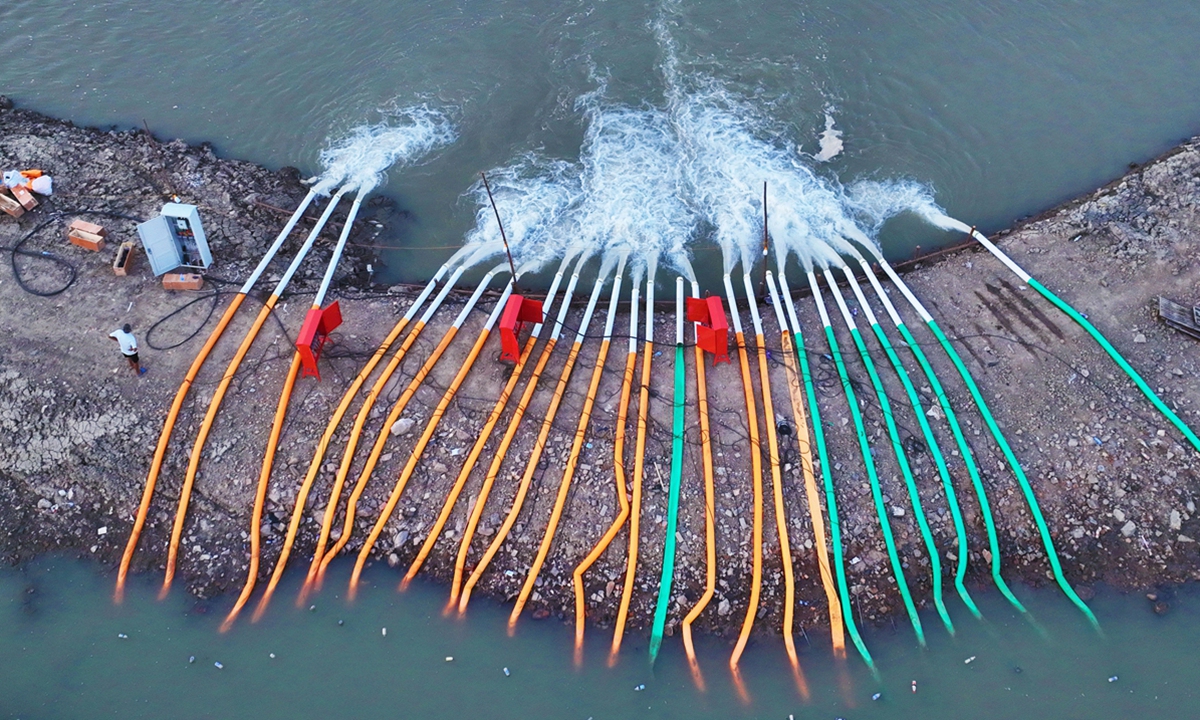
Water has been pumped from a canal to a waterway to ease the drought and ensure the harvest since August 18, 2022 in Ma'anshan, East China's Anhui Province as Chinese provinces and regions are battling prolonged heat waves. Photo: VCG
After China's Ministry of Agriculture and Rural Affairs (MOA) on Sunday declared an "all-out battle" to secure autumn grain harvest amid persistent drought, local governments and farmers in major planting areas are taking various approaches to ensure crop irrigation to minimize impact of the extreme weather on the critical autumn harvest.
With wide-ranging measures such as seeding clouds and the use of irrigation pumps, parched fields in dire need of irrigation would get timely help, industry participants and experts said on Monday.
As a traditional water-rich region, the middle and lower streams of the Yangtze River, one of the hardest-hit parts amid the current drought, will likely be exposed to only limited fallout from extreme weather, they noted.
Chinese Minister of Agriculture and Rural Affairs Tang Renjian presided over a meeting on Sunday, which called for "all-out battle" against high temperatures and drought to secure autumn harvest, according to the website of the MOA.
Regions equipped for irrigation are asked to coordinate the allocation of water supplies, while agricultural households are supposedly guided to implement deep water cooling, small water irrigation, and running water to dissipate heat in accordance with local high temperature and drought conditions.
In the case of hilly areas and other areas with insufficient water sources, the meeting called for the use of machinery, motor-driven wells, and other equipment to lift and deliver water.
In addition, on the part of the heavily disaster-stricken or even non-productive plots, it is necessary to replant late autumn crops in a timely manner, the meeting stressed, urging the drafting of targeted precautionary plans and technical guidelines to give details on disaster prevention and mitigation preparations.
"It hasn't rained since June and the drought remains severe," a staffer with a planting base with 20,000 mu (1,333.33 hectare) of rice crops in Wuhan, Central China's Hubei Province, told the Global Times on Monday.
There are two reservoirs close to the planting base, according to the staffer, who gave her surname as Hu. "We're now pumping water around the clock for irrigation, which can cover about 20,000 mu of farmland," she said.
Furthermore, the local government has resorted to seeding clouds, maintaining pumping equipment and other efforts to help farmers, Hu disclosed, forecasting losses of around 20 percent per mu in harvest due to drought this year.
Drought and high temperatures will inevitably weigh on crop yields, especially in some sloping and hilly areas that are inaccessible to timely irrigation, Jiao Shanwei, editor-in-chief of industry news website cngrain.com, told the Global Times on Monday.
Nonetheless, the reduced yields wouldn't be a nationwide concern, Jiao said, citing major producing areas, such as Northeast China and the middle and lower reaches of the Yangtze River, which are currently in good condition for autumn grain crops.
Although the middle and lower reaches of the Yangtze River are seriously affected by heat waves, the region, known for water richness and developed irrigation systems, would still guarantee harvests at large, as long as farmers can do a good job in water and fertilizer management, the expert continued, reckoning the impact on crops to be limited.
The agricultural authorities ought to strengthen guidance for farmers and introduce more policy measures and provide sufficient irrigation equipment, Jiao suggested.
While certain parched areas without adequate irrigation systems tend to take a battering from extreme weather, as measured by crop production, many more areas that strive to guarantee household water and irrigation facilities are still envisioned to embrace a harvest year, Li Guoxiang, a research fellow at the Chinese Academy of Social Sciences, told the Global Times on Monday.
Li said that the country can still basically achieve a bumper harvest of grain this year.
As part of efforts to replenish water supplies along the drought-plagued Yangtze River, reservoirs in the upper and middle reaches of the country's longest river were scheduled to discharge 1.48 billion cubic meters of water into the river's lower reaches, beginning August 16, Vice Minister of Water Resources Liu Weiping revealed at a press conference in Beijing last week.
Since August, reservoirs have been allocated to replenish 5.3 billion cubic meters of water in the middle and lower streams of the Yangtze River, Liu said.
Drought has affected roughly 830,000 people as well as 12.32 million mu of farmlands in six provincial regions - Sichuan, Chongqing, Hubei, Hunan, Jiangxi and Anhui, according to the Ministry of Water Resources.
At present, more than 7 million mu of crops in Hubei have been hit by drought. In response, in the Chenmiao River Basin in Huanggang in Hebei, a temporary cofferdam was built with sandbags to store water to cope with a possible prolonged drought, news site cctv.com reported on Sunday.
Along Zhangwan street in Wuhan, situated close to the Han River and Hanyang River, there is an area of about 40,000 mu of arable land. In early August, an irrigation unit of a local pumping station started operations, pumping the water from the Han River into the Baihu Canal.
Two submersible pumps were then used to transport the water into the Baihu Canal, before being pumped into the rice fields to ensure the irrigation of the local farmland.




